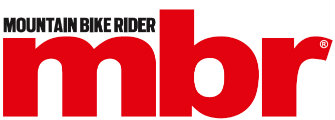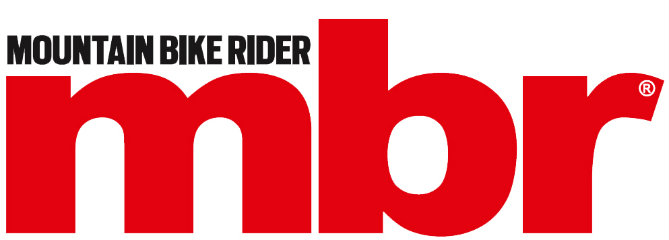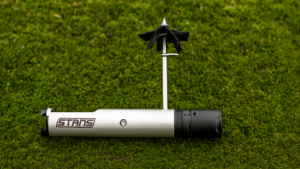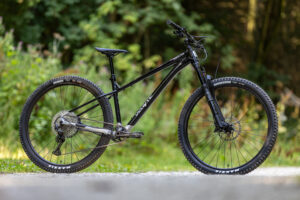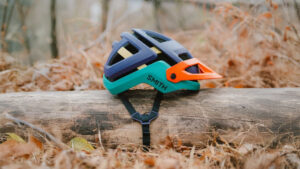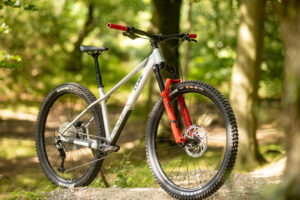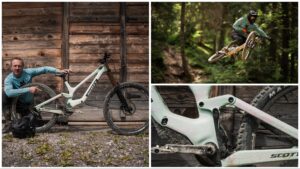The best mountain bike helmets need to protect your head and look (and feel) cool. We've tried and tested a huge selection to find out which offers the perfect blend, at various price points.
A good helmet is an essential piece of kit – you can ride without gloves, a jacket… pants even, but not a lid. We’ve extensively tested and reviewed all the best MTB helmets on the market, only the ones worth buying make it through to this stage.
In this guide you’ll find regular open-face helmets, suitable for most trail and cross-country riding. If you’re looking for full-face or convertible lid for bike park riding or gravity use, then check our our guide to the best mountain bike full face helmets.
Best MTB helmets – quick list
- Best overall helmet – Troy Lee Designs A3
- Best budget helmet – Specialized Camber
- Best helmet for extra protection – Fox Dropframe MIPS
- Best convertible helmet – Leatt MTB 3.0

Troy Lee makes the best helmet on the market in the A3: comfort, protection and style in one neat package
1. Troy Lee Designs A3
Best overall mountain bike helmet
Weight: 411g | Sizes: XS/S, M/L, XL/XXL | Rating: 9/10
Reasons to buy:
- Stunning looks from the TLD paintshop, and superb comfort
- Great protection, with EPS and EPP core and MIPS liner
Reasons to avoid:
- You’ll need deep pockets (unless it’s on sale, as it is right now!)
It’s fair to say the A3 is the best fitting and most comfortable helmet on sale. It’s extremely well padded, which does reduce the ventilation somewhat, but it’s not overly hot or sweaty like the A1.
The A3 is secured in place by a 360° retention band that encircles your head and is height adjustable. It’s really effective at stopping any wobble, and there’s silicone brow pad too (different sizes are included) that’ll channel away sweat… although it can stick to your head a bit).
To boost impact protection, the Troy Lee Designs A3 uses a dual-density EPS core with in-moulded mixes of EPP (expanded polypropylene) and EPS (expanded polystyrene), all wrapped up into a polycarbonate shell. To help deal with rotational impacts, the A3 gets a B-series MIPS liner integrated into the shell.
A great looking helmet that’s amazingly comfortable and packed with features, but demands a premium price.
Read our full review of the Troy Lee Designs A3 helmet

With vents galore, Bell’s Sixer MIPS is our summer helmet of choice
2. Bell Sixer MIPS
Best for ventilation / summer riding
Weight: 392g | Colours: White, grey, green, blue, Fasthouse | Sizes: S, M, L | Rating: 10/10
Reasons to buy:
- Cools well thanks to superb ventilation and air flow
- Great protection with two layers of EPS and a MIPS liner
Reasons to avoid:
- Slightly fiddly vertical retention adjustment
The Bell Sixer is made using something called Progressive Layering, where two densities of foam overlap to better protect your head. On the outside and under the regular nylon shell is a hard layer of EPS to stop anything penetrating, while inside is a softer layer which crumples more easily to spread the load. You also get a MIPS layer to help dissipate rotational forces.
Above all, venting is excellent on the Bell Sixer. There’s a large slit over the temple area and intake ports below, while long channels run the whole length of the helmet. At the back are big exhaust ports to draw the air through, making this helmet ideal for warm weather. There’s even a two-piece pad with the X-Static treatment inside to fend off pongs.
Read our full test review of Bell Sixer MIPS

If you don’t mind a fixed peak, the Camber kills it for value and comfort
3. Specialized Camber
Best value helmet
Weight: 392g | Sizes: S, M, L | Rating: 9/10
Reasons to buy:
- Great value for money
- Good ventilation
- Secure on-board glasses storage
- Lightweight and comfortable
Reasons to avoid:
- Minimal padding with no antibacterial treatment
- Less secure on rough terrain and a fixed visor
The Camber is a better value version of the Specialized Ambush 2, as such it gets lots of the high end features but without the cost. There’s a single layer EPS layer inside, with the added protection of a lightweight MIPS SL Liner.
Padding is minimal, but this actually works really well inside the Camber because the contact area is large and it spreads the load. The helmet features a really neat Integrated Fit system adjusted via a ratchet at the back, and that means Specialized has really nailed the details and the comfort too. It’s lightweight and cracking value for money.
Read our full review of the Specialized Camber helmet

The Dropframe boasts extra coverage, but there’s barely a weight penalty, and comfort is great too
4. Fox Dropframe MIPS
Best mountain bike helmet for extra protection and coverage
Weight: 391g | Sizes: S, M, L, XL | Rating: 10/10
Reasons to buy:
- Great extra coverage
- Still plenty of ventilation
- Lightweight design and a MIPS liner
Reasons to avoid:
- Visor isn’t adjustable
The Fox Dropframe is the best full face helmet with extra protection. Think of it as a half-way house between an open shell and a full-face, with more coverage on the side of your jaw, around the ear and at the back of the neck. It’s a divisive look, but the safety benefits can’t be denied and it’s also extremely lightweight despite the superior coverage.
Comfort and stability are first rate, and the Dropframe is super easy to put on because the sides flex slightly letting you pull them apart to clear your ears. Amazingly, the helmet boasts really good ventilation too, there are 15 ports and it’s breezy inside. This helmet fits like a glove, you could wear it all day.
Read our full review of the Fox Dropframe MIPS helmet

The Fox Speedframe Pro is a terrific all-rounder, protection is first rate and it fits well too
5. Fox Speedframe Pro
Best balance of comfort and protection
Weight: 437g | Sizes: S, M, L | Rating: 10/10
Reasons to buy:
- Speedframe looks brilliant, which shouldn’t matter but we all want to look cool, right?!
- Great protection wuth dual density EPS
Reasons to avoid:
- Liner moves around a little
- Internal shape doesn’t suit rounder heads
Fox uses its own Varizorb EPS liner to bolster protection, with two EPS layers joined internally to act as crumple zones and dissipate energy in a crash. There’s also the obligatory MIPS liner to offset additional rotational forces.
Fox has ensured ample venting too, and the visor tilts right up if you want to stash goggles underneath. Finally, clever features such as the quick-lock magnetic strap closure help elevate the Speedframe Pro above its rivals.
Looks great, feels great, lightweight… Fox has nailed it with the Speedframe Pro.
Read our full test review of Fox Speedframe Pro helmet

The Giro Source is an excellent helmet, with good protection and comfort… the women’s moniker just means it comes in smaller sizes
6. Giro Women’s Source MIPS
Best women’s mountain bike helmet
Weight: 347g | Sizes: S, M | Rating: 9/10
Reasons to buy:
- Uses a MIPS liner and there’s good all round and extended coverage
- Sweat-absorbing padding
- Indexed adjustment on the visor
Reasons to avoid:
- Chin strap buckle is small and flimsy
The Source features Giro’s Roc Loc 5 retention device, MIPS liner, Coolfit Ionic+ padding. The visor has indexed adjustment that allows you to park my goggles under it. The shell extends down over the temples and at the back, giving it extra coverage.
It fits really well, it’s comfortable, and the retention device is easy to adjust while riding. The venting is good, and it holds goggles securely in place. While this version of the helmet is labelled women-specific, it’s no different to the Giro Source MIPS: the only change is a unique selection of colours and a smaller size range offering.

Leatt has made a super-versatile helmet in its 3.0, full face, trail lid or extra protection… the choice is yours
7. Leatt MTB Helmet 3.0
Best convertible mountain bike helmet
Weight: 462g open-face / 587g with ears / 718g full-face | Sizes: S, M, L | Rating: 10/10
Reasons to buy:
- The 3-in-1 design means it’s really versatile
- Works out good value compared to three individual helmets
- It’s comfortable, stable, and easy to convert
Reasons to avoid:
- Quite difficult to take on and off with chinbar fitted
- It’s heavier than a specific open-face
- Glasses rattle against the underside of the brow
The Leatt MTB 3.0 is the best realised convertible helmet. By that we mean it can work as a full face downhill lid with full face coverage and a chin bar: an enduro helmet with extra protection around the sides: and a regular trail lid for maximum breathability.
It’s stable in each mode, and comfortable to wear thanks to good padding, and the venting is decent too. The MTB 3.0 fits together fairly easily too, so if you regularly ride at the bike park, on regular trails and ride enduro, it’s actually a brilliant proposition.
Read our full review of the Leatt MTB Helmet 3.0

It’s great to see brands like Scott develop products using with increased use of recycled materials.
8. Scott Tago Plus (CE)
Best helmet blending safety with sustainability
Weight: 370g | Sizes: S, M, L | Rating: 9/10
Reasons to buy:
- EPS foam and straps use recycled materials
- Lightweight and well ventilated
- A snug fit
- Good value
Reason to avoid:
- No XL size
- Limited space for camera/light mount
- Visor/peak is short in length
Other than the higher-priced Kali Protective Cascade helmet, the only other helmet we’ve recently tested that uses recycled materials is the more affordable Scott Tago Plus CE. A new addition to Scott’s range, the Tago Plus is packed with features and tech. It really impressed our tester, who commented on its slick looks, relatively low weight and pleasing fit.
Scott says that the EPS foam and straps used on the Tago Plus are made from fully recycled materials. The rest, including the buckle, are partially recycled and the brand promises there’s no compromise to the performance. Scott uses the popular MIPS system on this helmet, and while our tester noted that the padding is thin, this didn’t compromise comfort. He also praised the easy-to-operate, height-adjustable cradle – it really made it easy to get a good fit.
The Tago Plus is a helmet that’s hard to criticise. It’s relatively light, with a great fit and excellent ventilation. With the size L fitting heads up to 61cm, the lack of a size XL will be the only issue for some riders.
Read our full review of the Scott Tago Plus helmet

The Abus Moventor 2.0 MIPS helmet is a great choice for XC riding.
9. Abus Moventor 2.0 MIPS
Best helmet for low weight
Weight: 334g (M) | Sizes: S, M, L | Rating: 9/10
Reasons to buy:
- Lightweight
- Excellent ventilation
- High level of protection
- Ponytail cutaway in shell
- Compatible with Quin crash detection system
Reasons to avoid:
- Shell’s surface is easily scratched
- Conservative styling may not appeal to all
German brand Abus has really stepped up its MTB helmet game recently, with this Moventor 2.0 one of a trio in its reinvented range. With an airy, rounded shape sporting nineteen big vents, it’s more a cross-country or lighter-duty trail helmet. It’s MIPS equipped and is Quin-ready too. This means you can pay another £60 to add a Quin crash detection system that alerts emergency contacts to your location via GPS if you badly stack it.
At 334g (in a size medium), the Moventor is very light, despite being packed with features and MIPS safety tech. Most helmets in this class are hovering just under or above 400g , so this is a noticeable weight saving, without compromising performance or protection. Our tester found the fit system to be excellent, and noted that the height adjustment of the cradle was one of the best he’s used. It also has a really wide range over small increments, so you can get the lid gripping exactly where you want it.
Overall the Abus Moventor 2.0 MIPS is a helmet we found hard to criticise. It’s light, cool, comfortable and offers excellent protection at a reasonable price.
Read our full review of the Abus Moventor 2.0 MIPS helmet

Giro’s domed shape hides the clever and comfortable MIPS Spherical liner.
10. Giro Merit Spherical
Best helmet using MIPS Spherical safety tech
Weight: 365g (M) | Sizes: S, M, L, XL | Rating: 8/10
Reasons to buy:
- Packed with safety tech
- Low profile and close fitting
- Relatively low in weight
Reasons to avoid:
- Not the coolest-feeling lid
- Coverage not as deep as some helmets
- Expensive
This Giro Merit Spherical helmet shares loads of safety technology with the brand’s flagship Manifest helmet and saves you £50 by omitting only a few features. The Merit still uses Giro’s sophisticated multi-layer construction (developed with MIPS), where two separate helmet sections rotate independently of each other. Like a ball and socket joint, an inner and outer shell are connected via small elastomers, with the outer piece able to twist and slide separately to the part in contact with your skull.
Giro’s layered setup doesn’t creak like some MIPS lids can, and the Roc Loc cradle wraps the entire circumference of your head. It’s combined with an excellent interior shape and pad placement to keep the Merit super stable when riding. Air flow is pretty good, but this lid isn’t the absolute coolest on boiling hot days.
In our tests, the fit and function of Giro helmets usually hit the spot, and this well finished and high-quality Merit is no exception. It’s packed with safety tech, relatively light but isn’t the coolest-running helmet and also carries a high price tag.
Read our full review of the Giro Merit Spherical helmet

Exceptional fit and build quality separated the Sweet Protection Trailblazer from the pack.
11. Sweet Protection Trailblazer
Best helmet for long-term durability
Weight: 358g | Sizes: S/M, M/L, L/XL | Rating: 10/10
Reasons to buy:
- Comfortable design
- Noticeably cooling airflow
- Comes with spare pads and storage bag
- Very durable
Reason to avoid:
- Price has increased since our review
Sweet Protection is a Norwegian brand with a range of premium quality helmets, clothing and protection for mountain biking, as well as products for water and snow sports. The brand says that the Trailblazer is ‘the ultimate in trail helmet design’ and our tester Mick’s review aligned with this, as it scored a perfect 10 in a recent MBR helmet group test. The price includes a helmet bag and two sets of pads of different thicknesses.
The Trailblazer is a sorted design because the inside is perfectly sculpted and shaped, meaning fit and stability is better than any helmet our tester has worn or reviewed. The review also highlighted the Trailblazer’s superb ventilation with noticeable cooling all over the head, including the brow. Durability was praised too, as after two years of heavy use, Mick’s test Trailblazer helmet has shown very few signs of wear. The absorbent pads hadn’t come unstuck, none of the retention dials had broken and the visor and straps still worked as intended.
Mick’s test notes said that for the last couple of years the Sweet Protection Trailblazer helmet has become his go-to trail helmet and with no negative points to note – a price increase since our test date being the only downside.
Read our full review of the Sweet Protection Trailblazer helmet

Mips protection comes on many modern mountain bike helmets
Other mountain bike helmets to consider:
Kali Protectives has traditionally focused on the safety side of mountain bike helmet design but the Kali Cascade trail/enduro lid now uses recycled content in its straps and peak, along with a bamboo-based material for the padding. Along with the Scott Tago Plus, it’s one of the few helmets to move in this more environmentally-focused direction. We rated the Cascade as a smart eco choice, a helmet that doesn’t scrimp on protection and carries a lifetime crash replacement warranty.
We tested the updated Giro Montaro II helmet in 2022. This latest generation of the Montaro trail helmet still boasts impressive safety features and construction, but our review reported a marked increase in comfort. However, our tester noted a slight change with the sizing – the large Montaro we tested previously felt a little snug and perched, this one didn’t. There is a lot of good stuff about this helmet – the venting is excellent; the fit is superb and has a top-quality finish. It lacks a magnetic buckle though, and the coverage doesn’t extend quite as far down at the back as the many newer helmets in this category.

Endura’s MT500 MIPS also uses the Koroyd honeycomb structure.
After testing the first generation in 2021, we revisited this model a year later, with a full test of the revamped, second generation Endura MT500 MIPS helmet. We praised the original model for its comfort, low eight and neat design but while it was equipped with Koroyd – an energy absorbing material that’s a structural part of the helmet – it lacked the MIPS safety tech of helmets with a similar price tag. The latest model fixes this, with MIPS slide plane tech as standard as well as increased allround coverage and a sleeker looks.
We tested the Specialized Tactic 4 MIPS helmet in the spring of 2023 and scored it 8/10. Just like the Specialized Camber and Ambush 2 trail helmets that we’ve recently tested, the Tactic 4 sports an integrated and non-adjustable peak and MIPS safety tech. Our tester found the Tactic 4 MIPS to be a solid, well-made helmet and great value too. The limited fit adjustment for the cradle height was the only criticism.

The Troy Lee Designs Flowline MIPS Helmet offers the same great fit as the A3, with less ventilation.
In 2023 Troy Lee Designs launched an all-new trail helmet, in two spec levels, both with lower price tags than the highly-rated TLD A3 model. We tested the base-spec TLD Flowline MIPS helmet which is offered in three sizes and a huge range of colour options. Our review praised its stability, comfort, relatively low weight and multi-position visor. However, there are plenty of helmets offering similar performance and safety at a much lower price – maybe with just a touch less style though.
We reviewed the latest Mavic DeeMax helmet in spring 2024, four years after testing the original version of this open face trail lid. Our review mentioned the newer model’s solid build quality and neat features. However, our tester marked it down on its bulky looks and middling ventilation, also noting that it put pressure on his forehead.
The POC Kortal is a premium trail helmet from this Scandinavian brand. Our tester Mick Kirkman rated the lightweight, full-face POC Otocon Race helmet, so did this open-face lid impress him too? Overall he found POC’s Kortal to be a comfy helmet with good cooling, deep coverage and slick styling, but felt you can get a helmet with more features and just as much comfort from other brands, at a much lower price.
Mick also tested the Lazer Coyote KinetiCore, a well-priced and feature-packed trail helmet with a price tag just shy of £80. With an excellent safety rating, a modern aesthetic and decent comfort, the Coyote looked good. However, on fast and rough descents the adjustable visor just wouldn’t stay in place, continually moving down to its lowest position and into the line of sight. This was a dealbreaker for Mick, so hopefully Lazer will address this issue on the next generation of the Coyote.

The angular 100% Altec helmet gets a handy Fidlock strap that can be attached one-handed.
For an open-face helmet, the 100% Altec Fidlock feels reassuring and sturdy with a visor design that works well and has loads of space on top for POV cameras or lights to be positioned. When we first reviewed this helmet in 2020, our tester complained about the soft rubberised elastomers of the Smartshock digging in, but we had no issues this time round. If the fit is good, there’s a lot going on here for the asking price and the sculpted looks are on the money too.
MBR tested the Kask Rex enduro helmet back in 2016, scoring it a solid 8/10, and it’s still in the current range eight years on. However, the Kask Caipi is the brand’s newer and cheaper mountain bike helmet and we put it to test in 2022. With more cross-country styling, our tester found the Caipi to combine low weight and a stable fit, with plenty of breathability and ventilation for hard riding. It’s very light too – at 252g for a size medium – so ideal for fast-paced XC riding or racing.
The Abus Moventor 2.0 MIPS scored 9/10 when we tested it, so how did we rate the cheaper Abus MoDrop MIPS Quin trail helmet? Our tester preferred the look of the MoDrop over the Moventor but our review proves Abus has totally got its head around what’s required from a modern, mid-priced trail helmet in terms of fit and function. The MoDrop MIPS offers a superb fit, a good finish and is well priced too. You can also tune your requirements and add the brand’s QUIN chip to alert someone in the event of an accident for an extra £60, or buy the MoDrop without MIPS for a wallet-friendly £79.99.

The Dainese Linear 03 MIPS+has a distinctive design that won’t be everyone’s cup of coffee, but it’s extremely light for the protection on offer.
Italian protection brand Dainese has been out of the mountain bike helmet game for many years, but it now has the new Linea range that has been developed with leading motorbike helmet manufacturer and sister brand AGV. We reviewed the Dainese Linea 03 MIPS+ helmet, which comes loaded with safety tech and is lightweight too, with our test sample weighing only 335g. Our tester picked up on the kooky-looking visor and short chin strap but also felt the price was higher than helmets with a similar spec.
With an all-new range of helmets wearing the Trek (rather than Bontrager) brand name, we were keen to put one through our review process. We tested the Trek Blaze WaveCel, an enduro-focused helmet, with spring-loaded ear guards… the idea is you can use it for more aggressive riding with its ear protection in place, or fire them off at the press of a button when you’re on calmer terrain. Our tester felt that Trek has made one of the best vented and protective lightweight helmets out there but the ear protection compromised the comfort for him and a few other riders who tried it.

Modern helmets are packed with tech and have to pass a specific safety standard to go on sale.
How we test the best mountain bike helmets
All mountain bike helmets pass the current CE test so we’re taken it as read that they’ll work if you clonk your head on a passing tree. However, there’s currently no test for fit, venting or adjustability, which is why we’ve focused on these things when testing. To test the fit, we measured the shape of each one but that doesn’t reveal any hot spots, which is why we did lots of in-field testing, to test the true comfort. Riding hard we could also gauge the breathability and venting of the helmets.
Key features of the best mountain bike helmets:
The best mountain bike helmets sit a bit deeper on your head, extending down the nape of the neck, and they have extra coverage around the temples. Lots of helmets now incorporate some kind of rotational proection device, such as a MIPs liner, to reduce the risk of concussion. This can also be in the form of integrated reinforcement or crumple technology. There’s normally a visor, or peak, that you’ll be able to adjust up and down, and you may even see features such as integrated adapters to mount a POV cam or light, magnetic buckle closures, goggle strap clips and a storage bag.

Indexed visor adjustment let’s you push the peak up if you want to park your goggles
How to find your helmet size
Get hold of a fabric or paper tape measure if possible. If you don’t have one, don’t try and wrap a metal tape measure around your noggin, it doesn’t work – believe us. In the absence of a fabric/paper tape measure, find some string and wrap that around your head and note its length.
Whereabouts to measure around your head? Essentially around the widest (biggest circumference) part of your head. Around your forehead and around the most prominent bit of the back of your head. Note down the measurement in centimetres. All helmets have size ranges and with your head measured it’s then easy enough to find which sizing has your head size covered.
How often should you replace a helmet?
You should replace a helmet after any slightly significant impact or crash. A lot of helmet companies offer crash replacement schemes so it’s worth checking out their websites for info about such things.
In terms of general lifespan, it’s typically advised that you should think about replacing your helmet every two to three years. Some companies in the past have stated a longer term than this but we’d feel a bit iffy using a helmet that’s had more than three years proper trail riding use. General wear and tear as well as things like UV degradation can have negative affects on the performance and reliability of your helmet.

Fidlock magnetic closure on a chinstrap. These are quick and easy to fasten and open.
Best mountain bike helmets protection standards
All bike helmets sold in the UK need certification. This means helmets must meet certain fixed test criteria like impact velocities, roll-off tests, and strap system strengths. This is a minimum and many modern helmets surpass these requirements by incorporating composite materials into sub frames or “roll cages” for extra protection.
Crash replacement schemes
If your helmet is involved in an accident, most manufacturers offer a reduced price crash replacement scheme. With proof of original purchase, these programmes can save you up to 50% on an expensive replacement lid.
EPS
EPS (expanded polystyrene) foam is at the core of every bike helmet and works exactly like a crumple zone in a car. Modern helmets use different densities and some are even reinforced with an internal mesh or webbing.

The Mips liner is designed to slide within the helmet in a crash, reducing the rotational and acceleration forces on your brain.
MIPS
Multi-directional Impact Protection System is a patented protective liner that slides when your head hits the ground, reducing the force of them impact and likelihood of a concussion or brain injury. MIPs is a branded product so several manufacturers do their own version usually with an equally ambiguous abbreviation.

The inside of a Koroyd-equipped helmet
Padding
Padding thickness and density has a significant effect on sweat absorption, cooling and comfort. Thicker internal padding may run a little hotter but you’re less likely to get sweat running down your neck and the helmet will generally feel more comfortable. Channels are often formed into padding to improve air flow and speed up drying.
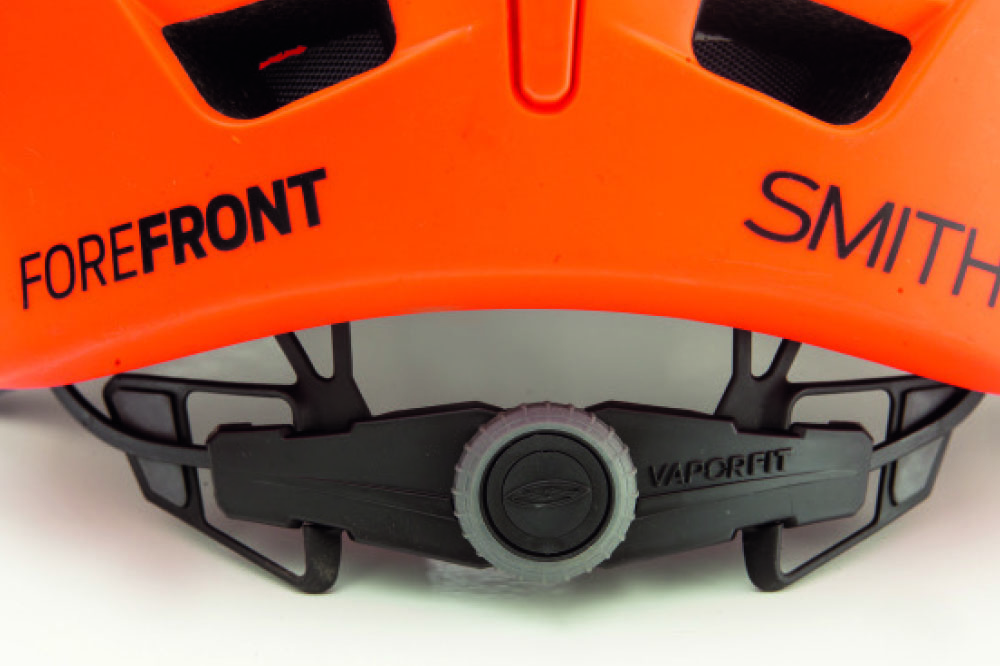
The retention band is usually adjusted via a dial at the rear.
Retention device
Like in a baseball cap, a retention device allows you to adjust the fit of the helmet. Most use a dial, which allows you to tune the tension/size with one hand while riding. You can also adjust the height using press-studs or a sliding clip.

Flip a helmet over and you can see the EPS (expanded polystyrene) inner.
Shell
To reduce dings and dents, the EPS it’s covered with a thin plastic micro-shell. This is usually in-moulded with the foam during the manufacturing process and can be one or several pieces.
Ventilation
Vents at the front of the helmet allow air to flow in and those at the back let it flow out again. Generally, the more the merrier but the shape and angle of the vents and how they integrate with the peak is key to keeping cool.

This visor position is adjustable, with ample room for stowing glasses or goggles
Visor/Peak
Being able to tilt the visor up means it doesn’t block your vision when riding with you head down but it also allows you to ‘park’ your goggles underneath. To hold the goggle strap securely, most helmets have a channel called a strap-gutter round the back but we also see clips or small tethers.

If you wear goggles sometimes, it’s good to check the lid will accommodate them properly
Goggle parking/strap gutter
On some helmets the visor can be tilted up so you can ‘park’ goggles underneath when you’re not using them. Usually this feature comes hand in hand with a strap gutter – a shallow channel on the back of the helmet that holds the strap in place.

An example of a bottom-wrapped helmet
Bottom wrapping
To add extra protection to the lower edge of the EPS the micro-shell often wraps under the bottom of the helmet.
Sizing
Helmets come in various sizes. Small, medium and large is pretty standard but you also see overlapping sizes like S/M and M/L. One company’s medium can also be another’s large and some helmets are long and thin, while others are short and squat. All of which means there’s no consistency in sizing or fit and you should always try before buying.
